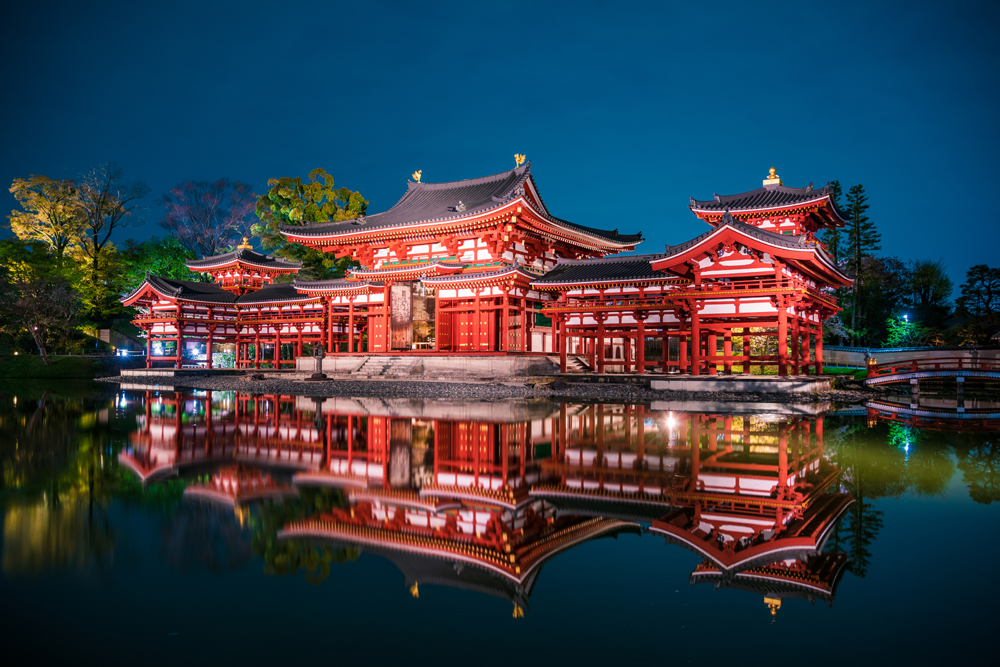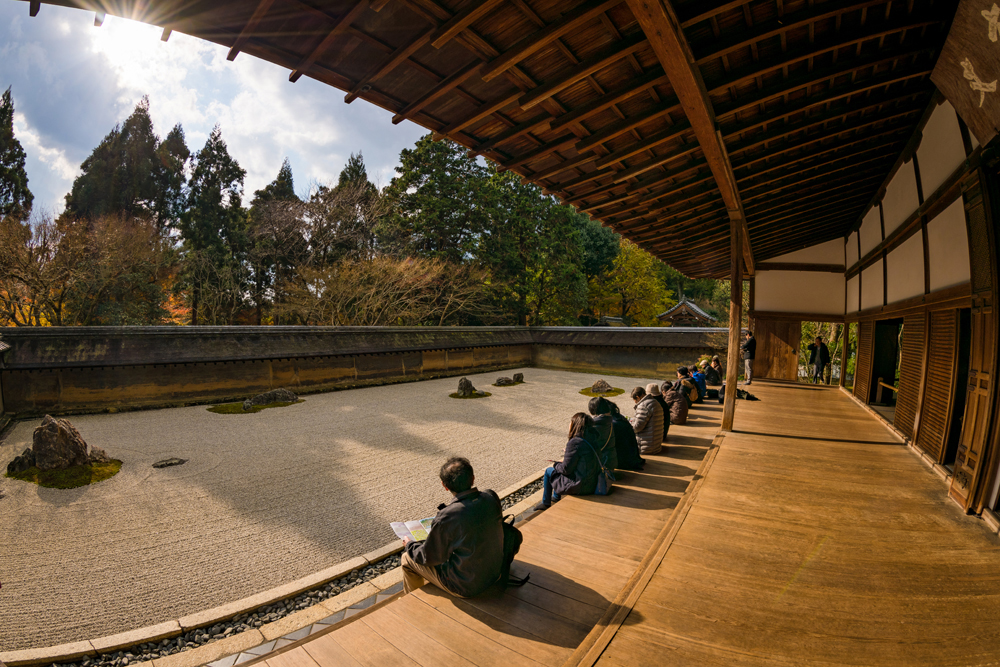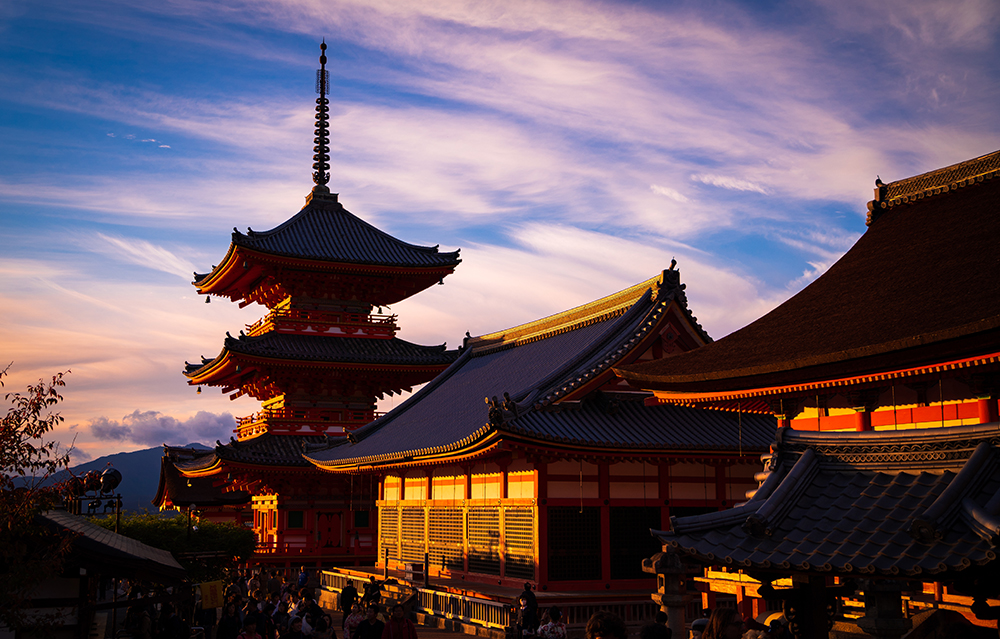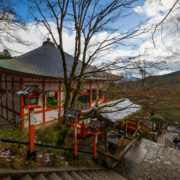Best UNESCO World Heritage Sites in Kyoto, Japan
Kyoto, Japan has 17 UNESCO World Heritage Sites, all of which we’ve visited. In this post, we share the full list, ranking these temples & shrines from worst to best, and discussing which you should see and which you should skip.
As a bit of background, UNESCO World Heritage Sites are landmarks selected by the United Nations Educational, Scientific and Cultural Organization (UNESCO) as having cultural, historical, scientific or other significance, and legally protected by international treaties. The sites are judged as important to the collective interests of humanity and preserved as such.
In general, the UNESCO World Heritage Site list is somewhat controversial. This is in part because the very act of listing a landmark leads to an influx of invasive tourism, which can undermine the positive impact of the protections. Additionally, because there’s often a lack of consensus about which locations are and are not deserving. This is especially true in Kyoto…
When it comes to Kyoto, there’s no shortage of important cultural properties. With regard to UNESCO, a few dubious choices make the list and there are also some notable omissions. For example, Kozan-ji Temple makes the cut, despite being #79 on our Top 100 Temples & Shrines in Kyoto, Japan. However, 4 of our top 5 and do not make the list, and only half of our top 10 makes the cut.
Obviously, personal tastes may vary, and UNESCO is weighing historical significance much more heavily than we are, but their list is still far from infallible. Nevertheless, we realize many travelers have UNESCO ‘checklists’ of sorts, and aim to visit every World Heritage Site in the places they visit.
Anyway, here’s the UNESCO World Heritage Site list for Kyoto from worst to best…
17. Ujigami Shrine – By any reasonable account, this minor shrine in the famed tea town of Uji is a blip on the radar, a skippable spot even if you make the trek to Uji. There are dozens of temples and shrines that are more fascinating in the Kyoto area.
Ujigami Shrine makes the UNESCO World Heritage Site list because its classic architecture and history as possibly be the oldest extant Shinto shrine in Japan. It’s definitely not worth seeking out, but if you’re already in Uji, you might as well cross the river to check it out.
16. Kozan-ji Temple – This approach to this temple in the mountain village of Takao is the highlight, as the pathways leading here are surrounded by towering cedar trees and a moss covered forest floor. From there, it’s mostly a letdown, as Kozanji Temple is the least impressive of Takao’s big three, none of which are all that great. (Skip Takao entirely.)
Kozanji Temple makes the UNESCO World Heritage Site list due to the treasured “Choju Jinbutsu Giga” (“The Scrolls of Frolicking Animals and Humans”), which are famous picture scrolls featuring frogs, monkeys, birds, and rabbits engaged in worldly pursuits. This is sometimes described as Japan’s first comic, and there’s a good chance you’ve seen it depicted before.
15. Nishi Honganji Temple – Although it doesn’t rank highly when viewed on its substantive merits, Nishi Honganji Temple is one you can easily cross off your list because it’s within a 10 minute walk of Kyoto Station. It also doesn’t hurt that admission is free.
This is one of two head temples of the Jodo Shinshu sect of Buddhism in Kyoto. Both of these temples are called Honganji, and this is the western one. The eastern Honganji Temple is very similar, and is a located nearby. Despite the short distance, visiting both is somewhat redundant.
14. Shimogamo Shrine – Also known as the Lower Kamo Shrine, Shimogamo is located at the junction of the Takano and Kamo rivers north of Kyoto Gyoen and the Imperial Palace. It’s not too bad of a walk from Demachiyanagi Station, scoring it some points in terms of accessibility.
Shimogamo Shrine is in a large park public and surrounded by an old growth forest that predates the modern city, with trees that are hundreds of years old. The shrine buildings are vibrant and photogenic, and due to its location in an old growth forest, you can find stunning fall colors here in the autumn.
13. Kamigamo Shrine – Also known as the Upper Kamo Shrine, this is located 3.5 km north of Shimogamo Shrine, and is also on the bank of the Kamo River. Due to its more remote location, this is the less-visited of Kyoto’s two Kamo Shrines, and is probably skippable for most visitors to Kyoto who are tight on time.
By a slight margin, we prefer Kamigamo Shrine, which is famous for its two sand cones that purify visitors to the shrine. Kamigamo Shrine is particularly gorgeous during sakura season, thanks to giant weeping cherry trees in the park outside its main gates.
12. Tenryu-ji Temple – The most popular spot in all of Arashiyama, we think Tenryuji is a bit overrated. Not that it isn’t impressive–it is–but it’s one of the top 5 temples in Kyoto when judged by crowds, and we just don’t see that level of appeal.
Tenryuji Temple is the head temple of its own school within the Rinzai Zen sect of Japanese Buddhism, and is ranked first among Kyoto’s Five Great Zen Temples. Given that and it’s easily accessible location, don’t take our word as the gospel–visit Tenryuji and form your own opinion.
11. Enryaku-ji Temple – Located high in Kyoto’s eastern mountain range on Mount Hieizan, Enryakuji is one of the most important monasteries in Japanese history and the headquarters of the Tendai sect of Japanese Buddhism. Many influential monks studied at Enryakuji, including the founders of a number of other temples (many of which came to be considered subtemples of Enryakuji).
Enryakuji is an impressive temple, but it’s also a massive headache to get there, both in terms of time and money. On the other hand, there are some beautiful buildings, good hiking, and if you don’t get a chance to ride a cable car elsewhere in Japan, that can be a fun part of the experience, too.
10. Daigoji Temple – Another sprawling temple complex with beautiful features, Daigoji is in the suburbs to the southeast of Kyoto, and requires a half-day trip to reach (but can be nicely paired with Byodoin Temple or even Fushimi Inari).
Daigoji Temple is also expensive, and visiting both the lower and upper grounds will cost you over 2000 yen during peak fall and spring seasons. Nevertheless, it features some iconic structures and lovely gardens.
9. Nijo Castle – We don’t hate Nijo Castle, but we don’t love it, either. The word “castle” in the name ensures there’s a constant stream of tourists, and we’d hazard a guess that it doesn’t live up to their preconceptions of what a Japanese castle will resemble.
While Osaka or Himeji Castles better look the part, Nijo Castle has beautiful grounds and gardens, and its place in Kyoto’s history is indisputable. It’s an obvious and appropriate choice for inclusion in UNESCO’s list, but it’s not an essential point of interest for tourists.
8. Byodoin Temple – This Pure Land Buddhist temple features some of Japan’s most eye-catching architecture. Built in 998 as a countryside retreat palace for the politician Fujiwara no Michinaga, Byodoin was not initially viewed as a temple. It was converted to a temple by Yorimichi Fujiwara, who also ordered the construction of Byodoin’s most striking building, the Phoenix Hall.
Despite being in Uji, Byodoin Temple is only 30 minutes away from Kyoto Station via an easy train ride. We love Byodoin Temple, and highly recommend this UNESCO World Heritage Site is a must-visit.
7. Toji Temple – Located within walking distance of Kyoto Station, Toji Temple is famous for having the tallest pagoda in Japan, which is likely why it makes UNESCO’s list. Together with the now defunct Saiji Temple, Toji formed Kyoto’s “Guardian Temples” that marked the south entrance to the city.
In addition to the pagoda, Toji Temple has a number of other structures, including Kondo Hall, which is the temple’s main hall and largest building. It houses a large wooden statue of Yakushi Buddha, who is flanked by his two attendants, the Nikko and Gakko Bodhisattvas. Toji Temple is most beautiful during fall colors and spring sakura seasons.
6. Ryoanji Temple – Renowned for its rock garden, which is arguably the most famous in Japan. This garden is popular, in large part, because its origins are unclear, as is its meaning. The rock garden being shrouded in mystery and leading visitors to ponder its meaning, and project their own interpretation, certainly lead to its popularity.
Ryoanji Temple’s rock garden is beautiful and interesting, but just as impressive is the temple’s unique design around a large pond, and the outlying buildings that are scattered through the woods. Those buildings themselves also hold a lot of beauty, particularly in the form of the paintings on the fusuma in Hojo, the head priest’s former residence from which you view that famous rock garden.
5. Ninnaji Temple – The free grounds here are lovely, with the five-storied pagoda towering visible from a distance. However, it’s the paid Goten building, the the closest most people will get to being inside an imperial palace in Kyoto, that likely earns it a place on the UNESCO World Heritage Site list.
The beautiful fusuma that are painted to represent the four seasons in Kyoto are a personal highlight in Goten, but the peaceful and meticulously designed gardens rival those fusuma for that title. There’s also a strong sense of shakkei in the gardens here, as they borrow from the scenery of the outer grounds to really enhance their scenery.
4. Kokedera Temple – Also known as Saihoji or simply the Moss Temple, Kokedera is one of the most spectacular places in Kyoto. It’s one of the most difficult to access UNESCO World Heritage Sites, not because of remote location, but because of a cumbersome mail-only reservation process. It has also gained recognition as Steve Jobs’ favorite place in Japan.
Kokedera Temple’s garden is said to have over 120 different varieties of moss, and the whole place looks like a lush fairytale scene. Participating in the temple’s ritual and lingering in the serene moss garden afterwards ranks as one of our all-time favorite experiences in Japan.
3. Golden Pavilion (Kinkakuji Temple) – Someone should write a short story about Golden Pavilion titled a “Tale of Two Temples.” Go in the middle of the day, and it’s a slow trudge amongst a sea of selfie-stick wielding tourists in bedazzled attire eager to snap an Instagram-perfect photo of themselves in front of the famed gold-colored temple building. It’s totally superficial, and the crowd levels almost necessitate that type of ‘go, look, leave’ type of experience.
Go very first thing in the morning or 45 minutes before Golden Pavilion closes, and more details around the temple grounds reveal themselves, and you can have an experience that is more serene, and less of a cattle call. While UNESCO might’ve listed this temple for the iconic golden building, there’s more to Kinkakuji Temple than meets the eye.
2. Silver Pavilion (Ginkakuji Temple) – It’s not actually covered in silver, and is instead a rather modest and relatively unremarkable pavilion. Nevertheless, the whole package of the Silver Pavilion offers more than the Golden Pavilion–and it’s less crowded (but still pretty popular).
At the Silver Pavilion, it’s the whole package that impresses: the half dozen other temple buildings, the dry sand garden, and the moss garden spread across beautiful forested grounds. It’s an excellent place to explore, and perfectly encapsulates the vibe of a zen temple.
1. Kiyomizudera Temple – From the approach through the preserved streets of the Higashiyama District to wandering the paths that lead to the temple’s outlying buildings, there’s something special about Kiyomizudera. This temple’s status as a UNESCO World Heritage Site is unquestionable–it’s an exemplar of Kyoto’s temples, featuring excellent variety: large main hall, pagoda, shrines, waterfall, plus stunning views of the city and mountains.
Kiyomizudera Temple is especially beautiful during the fall colors and cherry blossom seasons, when the temple has an added splash of color, and is enhanced by the natural beauty of foliage and sakura. While the whole experience is dampened right now by the large-scale refurbishment of the temple’s famed main hall, it still deserves a spot at the top of any list about Kyoto.
If you’re planning a trip to Japan that includes Kyoto, we recommend that you start by consulting our Ultimate Guide to Kyoto, Japan to plan all aspects of our vacation. You should also check out our other posts about Japan for ideas on other places to visit!
Your Thoughts
Have you visited any of the UNESCO World Heritage Sites in Kyoto? What did you think of them? Would you recommend any of them to a first-timer visiting Japan? Do any of these UNESCO temples or shrines appeal to you? Any thoughts or tips of your own to add? Any questions about what we’ve covered here? Does visiting this spot in Kyoto interest you? Hearing about your experiences—even when you disagree with us—is both interesting and helpful to other readers, so please share your thoughts below in the comments!




























Absolutely beautiful photos, Tom! I hope you make a book… or maybe a few… some day. I would love to ha a Tom Bricker hardcover photo book or three on my coffee table.